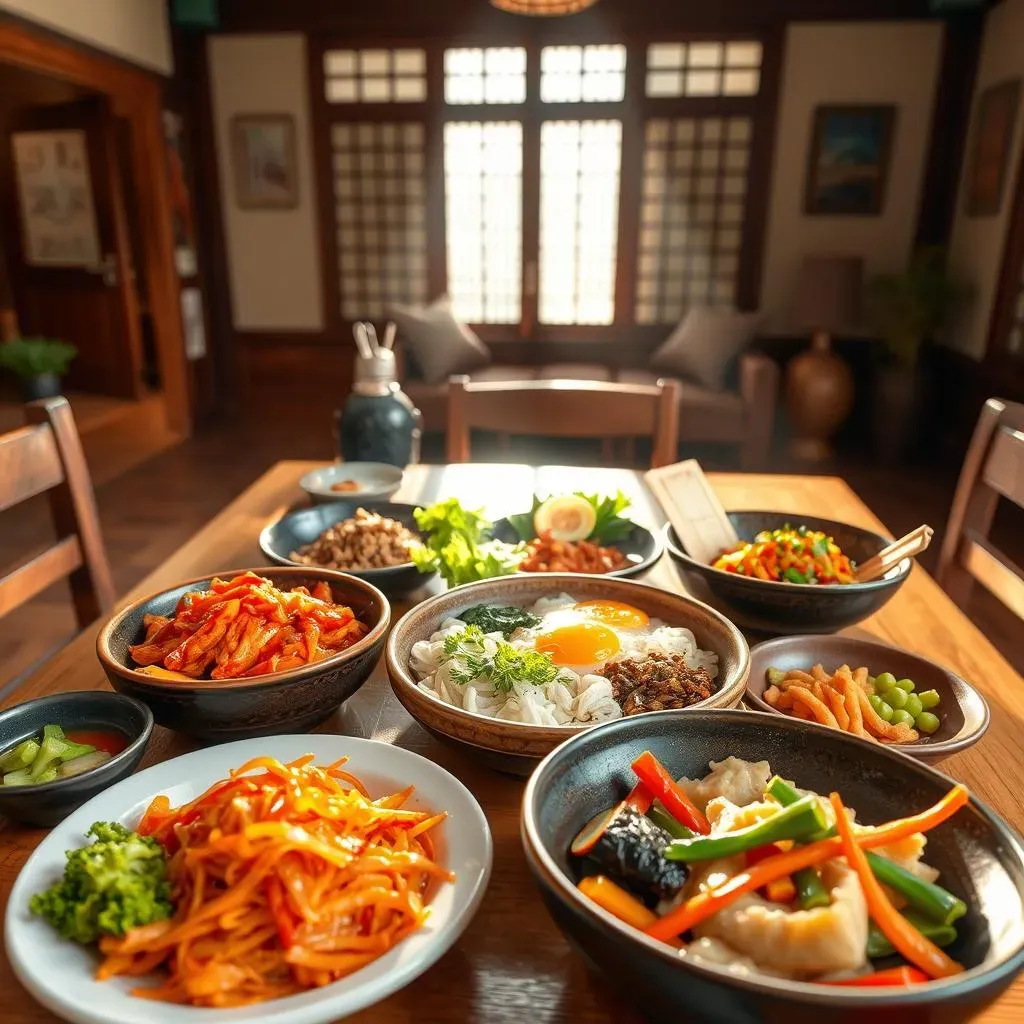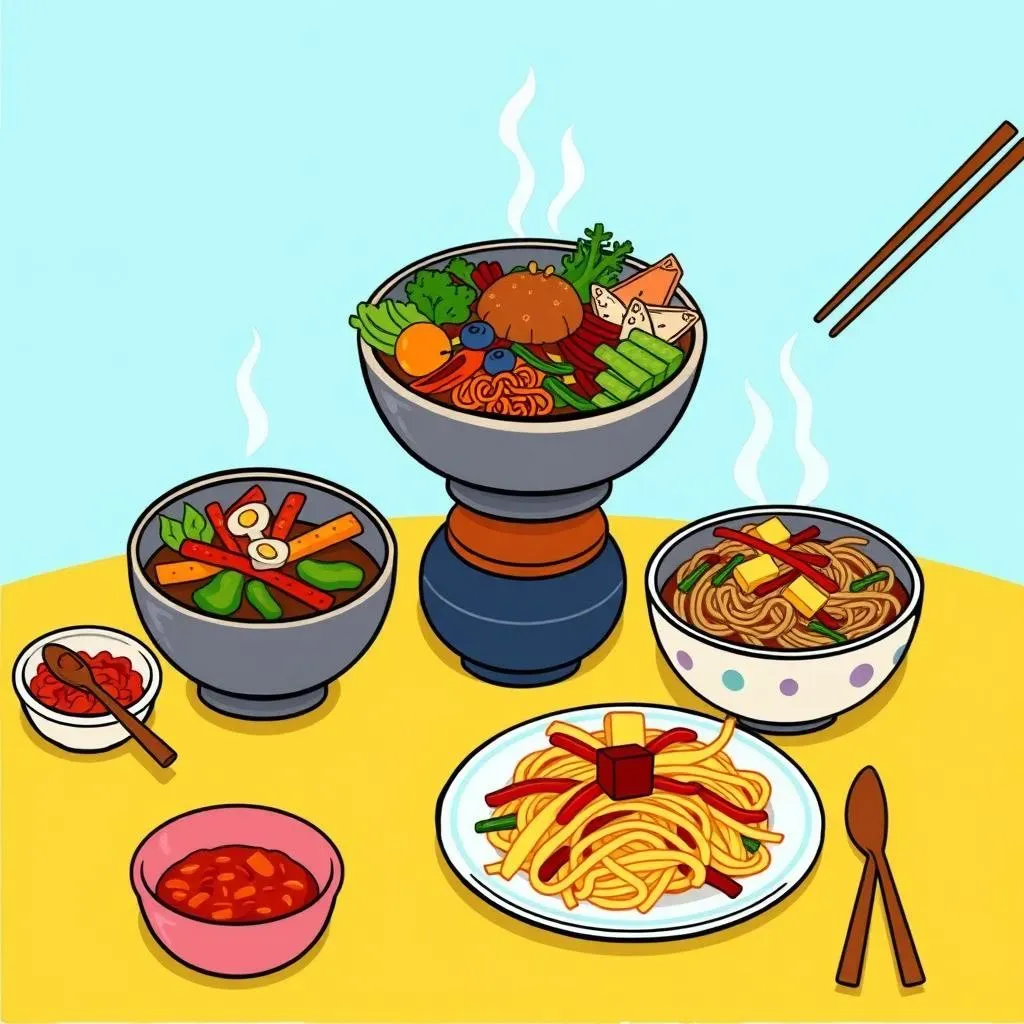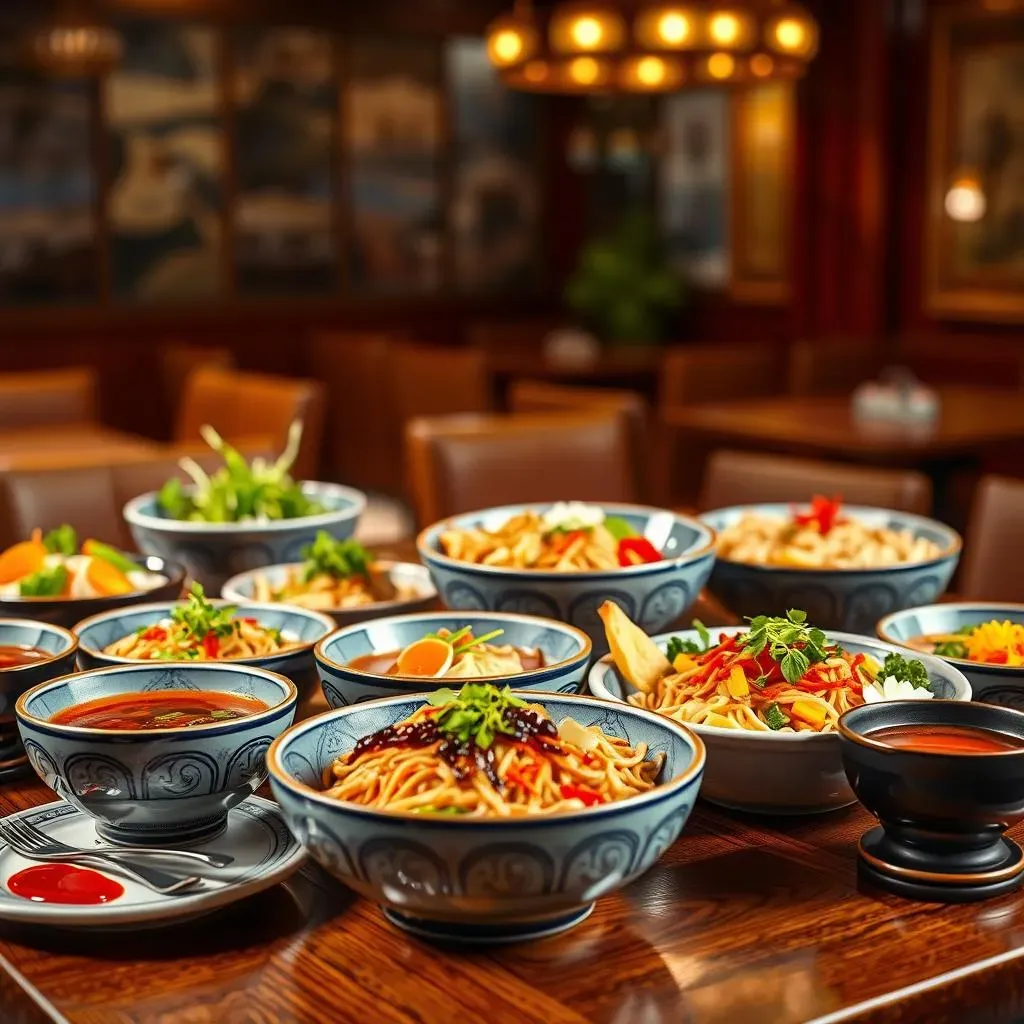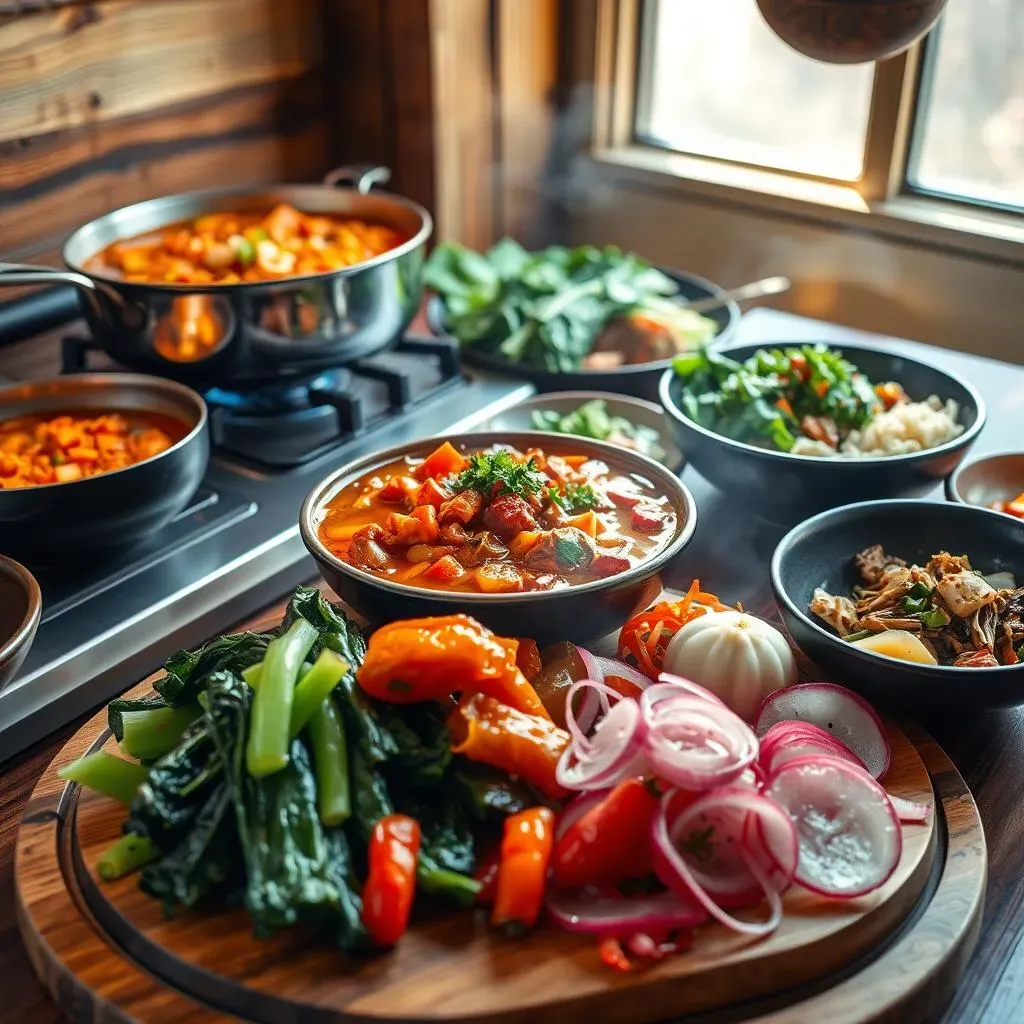Table of Contents
Ever wondered if Korean food could be both incredibly delicious and completely plant-based? Well, get ready to have your mind blown! Korean cuisine, with its rich history of using grains, legumes, and veggies, is surprisingly easy to adapt for vegetarians and vegans. Forget the idea that it's all about meat; many traditional Korean dishes are naturally plant-based, or just a tweak away from being so. In this article, we're diving into the world of the best vegetarian Korean dishes, from spicy kimchi to savory stews and comforting noodle bowls. You'll discover how Korean temple cuisine, which is entirely vegan, has shaped the country's food culture. We will explore a range of recipes, showing you how to make amazing Korean meals that are healthy, satisfying, and bursting with flavor. Get ready to explore the vibrant world of Korean vegetarian cooking. Let's get started!
Naturally Vegan Korean Dishes
Naturally Vegan Korean Dishes
The Hidden Vegan Gems
You might be surprised, but many traditional Korean dishes are naturally vegan. It's not all about meat and seafood. Think about it: Korea's culinary roots are deeply intertwined with Buddhism and temple cuisine, which is 100% plant-based. This means there's a whole treasure trove of dishes that are naturally free of animal products. We're talking about vibrant vegetable side dishes, hearty soups, and flavorful rice bowls that have been enjoyed for centuries. These aren't some modern invention; they're the real deal, the backbone of Korean cooking.
I remember the first time I visited a traditional Korean temple. The food was simple, but it was packed with flavor. It made me realize how much of Korean cooking is already plant-based. It's like discovering a secret garden of vegan deliciousness right under your nose. We are going to look at some of these gems.
Dish | Description |
|---|---|
Kimchi (some varieties) | Fermented cabbage and vegetables, often vegan |
Bibimbap (without egg/meat) | Mixed rice with veggies, gochujang, and seaweed |
Japchae (some versions) | Glass noodles with stir-fried vegetables |
Exploring Plant-Based Staples
Korean cooking relies heavily on staples that are naturally vegan. We're talking about rice, of course, but also a whole world of amazing vegetables. Think of things like spinach, bean sprouts, and daikon radish, which are all used in various ways to create delicious dishes. Then there are the wonderful legumes, like soybeans, which are the base for many Korean sauces and dishes. The use of tofu is also very common in Korean cooking. These are not just ingredients; they're the building blocks of delicious and naturally vegan Korean meals. It's all about using these plant-based ingredients to create amazing dishes.
I think the best part is how these dishes are not only healthy but also packed with flavor. It's a testament to the creativity of Korean chefs who have been making delicious plant-based food for centuries. They show us that you do not need meat to have a satisfying meal.
EasytoVeganize Classic Korean Recipes
EasytoVeganize Classic Korean Recipes
Making Simple Swaps
Okay, so maybe you're looking at some Korean dishes and thinking, "That looks amazing, but where's the vegan version?" The great news is, many classic Korean recipes are super easy to make vegan with just a few clever swaps. It's all about identifying the non-vegan ingredients and finding plant-based alternatives. For instance, if a dish calls for beef, you could easily use mushrooms or tofu instead. If it uses fish sauce, try soy sauce or a vegan fish sauce alternative. It is not about changing the whole dish, it's about making some small adjustments that can make a big difference.
I always thought it would be so hard to make Korean food vegan, but I was wrong. It's actually quite simple, and you can still enjoy all the same flavors. You don't need to be a culinary wizard; it's about being adaptable and knowing where to make the adjustments.
Examples of Vegan Swaps
Let's look at some examples of how you can make these swaps. Take Bibimbap, for example, a colorful rice bowl. Traditional versions often include a fried egg and beef. To make it vegan, simply leave out the egg and use mushrooms or marinated tofu instead of beef. You still get the same deliciousness with all those amazing veggies and gochujang sauce. Another example is Japchae, a noodle dish; just make sure to use a vegan version of the sauce and load up on the veggies. It's really amazing how these dishes can be transformed with just a couple of simple ingredient changes.
I was surprised when I realized how versatile Korean food really is. It's not as rigid as I initially thought. It's about understanding the base flavors and then making small changes to suit your diet. It's all about being creative and making it your own.
Original Ingredient | Vegan Swap |
|---|---|
Beef | Mushrooms, Tofu |
Egg | Omit or use silken tofu |
Fish Sauce | Soy Sauce, Vegan Fish Sauce |
Honey | Maple Syrup, Agave |
Best Vegetarian Korean Noodle and Rice Dishes
Best Vegetarian Korean Noodle and Rice Dishes
Noodle Nirvana
Okay, let's talk noodles! Korean cuisine has some seriously amazing noodle dishes that are perfect for vegetarians. Forget the plain pasta; we're talking about glass noodles, chewy wheat noodles, and even cold buckwheat noodles. These aren't just carriers for sauce; they're a key part of the dish, each with its own unique texture and flavor. Japchae, for instance, is a stir-fry with glass noodles, veggies, and a savory sauce. It's a must-try for any noodle lover. Then there's Janchi Guksu, a warm noodle soup that's simple, comforting, and packed with flavor. These dishes are not only delicious but also super satisfying.
I still remember the first time I tried Japchae; the noodles were so springy and flavorful. I was instantly hooked. It's like a party in your mouth, with all the different textures and tastes combining perfectly. I think that noodles are the best way to explore the Korean cuisine, they are the foundation of many Korean dishes.
Rice is King
Now, let's move on to rice. In Korean cuisine, rice isn't just a side dish; it's the heart of many meals. There are so many ways to enjoy rice in a vegetarian Korean meal. Bibimbap is a classic example, a mixed rice bowl with colorful veggies, gochujang, and often a fried egg, which you can easily omit for a vegan version. You can also try Kimbap, which is Korean sushi, but instead of fish, it's filled with veggies. Rice is a staple in Korean cooking, and it’s used in so many creative ways that you'll never get bored.
I always love how versatile rice is in Korean cooking. It's not just a blank canvas; it's a star in its own right. It perfectly complements all the other flavors in a dish. I think that rice is the perfect way to enjoy Korean flavors.
Dish | Description |
|---|---|
Japchae | Glass noodles with stir-fried vegetables |
Bibimbap | Mixed rice with veggies, gochujang, and seaweed |
Kimbap | Rice rolls with veggies and seaweed |
Janchi Guksu | Warm noodle soup with veggies |
A Symphony of Flavors and Textures
What makes these noodle and rice dishes so special is the combination of flavors and textures. The chewy noodles, the crunchy veggies, the savory sauces, and the fluffy rice all come together to create a truly amazing culinary experience. It's not just about eating; it's about exploring the different layers of flavor and texture in each dish. You'll find that Korean cuisine is all about balance, and these dishes are a perfect example of that. It is a perfect mix of flavors and textures.
I think that the best part is how these dishes are not only delicious but also visually appealing. The vibrant colors of the veggies and the sauces make each meal a feast for the eyes as well as the stomach. It's a testament to the creativity and artistry of Korean cooking.
MustTry Vegetarian Korean Stews and Sides
MustTry Vegetarian Korean Stews and Sides
Hearty and Flavorful Stews
Okay, so we've covered noodles and rice, but let's not forget about the amazing stews! Korean stews are like a warm hug on a cold day, packed with flavor and veggies. They're not just watery soups; they're hearty and satisfying meals. Think about Kimchi Jjigae, a spicy and tangy stew made with kimchi, tofu, and veggies. You can easily make it vegetarian by using vegetable broth and omitting any meat. There is also Sundubu Jjigae, a soft tofu stew that is rich and flavorful, and it's naturally vegetarian if you avoid the seafood versions. These stews are perfect for when you want something comforting and delicious.
I remember when I first tried Kimchi Jjigae; the spice was so invigorating, and it was packed with so much flavor. It was like an explosion of taste in my mouth. I was hooked from the first spoonful. These stews are the epitome of Korean comfort food and are amazing way to enjoy Korean cooking.
The Magic of Korean Side Dishes
Now, let's talk about the unsung heroes of Korean cuisine: the side dishes! These aren't just afterthoughts; they're an essential part of any Korean meal. They add variety, flavor, and texture to your plate. We're talking about things like seasoned spinach, pickled radish, and braised potatoes. There are also the various types of kimchi, a fermented vegetable dish that's a staple in Korean cooking. Many of these side dishes are naturally vegan or easily made vegan. They’re often bursting with flavor and are the perfect complement to any main course. It's all about balance and variety.
I love how each side dish is so different and unique. They add a whole new dimension to the meal. It's like a little adventure on your plate, with each bite bringing something new. These side dishes are a testament to the creativity and resourcefulness of Korean cooks.
Dish | Description |
|---|---|
Kimchi Jjigae | Spicy kimchi stew with tofu and veggies |
Sundubu Jjigae | Soft tofu stew with veggies |
Seasoned Spinach | Blanched spinach with sesame oil and garlic |
Pickled Radish | Sweet and tangy pickled radish |